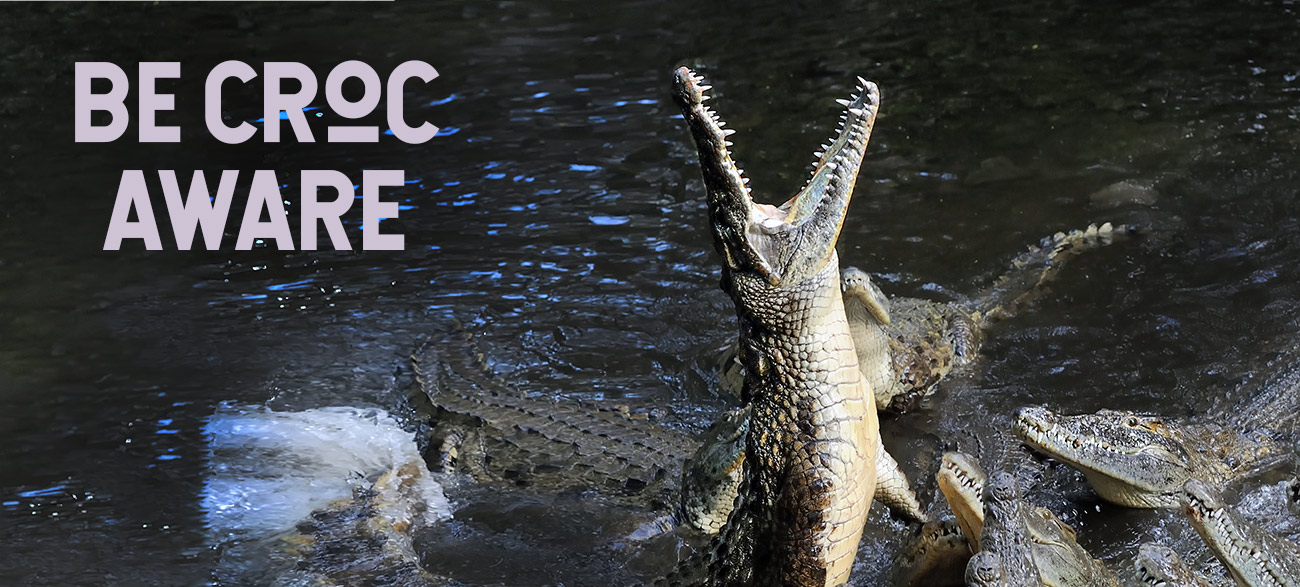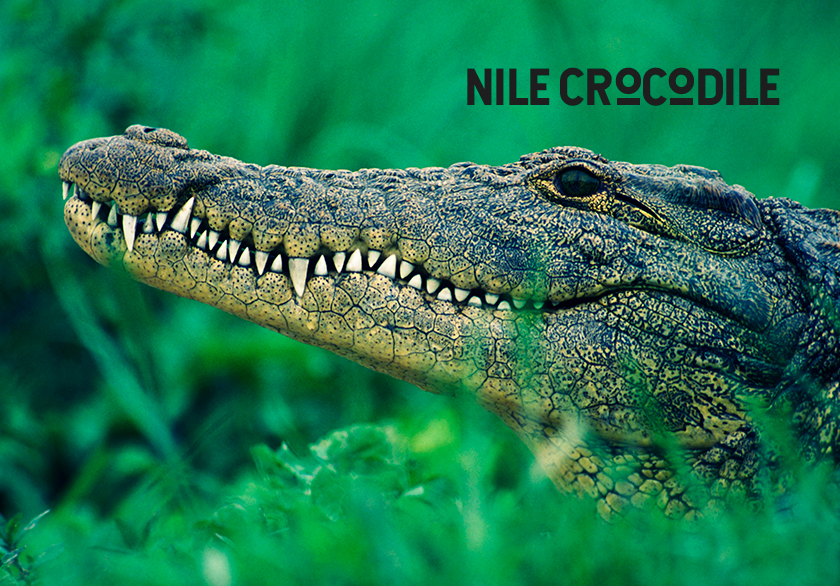How to Survive a Crocodile Attack


Scenario: You’re face to face with a giant croc. What do you do? Now, what if it manages to clamp down on your arm or leg? Is there any way out? If you’re like me, you may have thought about this once or twice.
I wrote this article because I know a few people who got chomped and I want to make sure you have the best chance to survive should it happen to you. Essentially, I hope this gives you the best science-based advice to surviving a crocodile attack.

Crocodile Basics
While there are 25 species of crocodilians, not all pose a serious threat to humans. Generally these reptiles have to be 8 feet or larger to be physically able to eat a person, and not all species get that large.
It’s hard to tell exactly how many people are eaten a year by crocs because it’s often remote jungles and swamps where big crocs thrive. Many attacks are not reported to authorities, so the numbers are not exact. A few sources estimate it could be somewhere between 300 and 1,000 people a year that are taken by crocodiles. Most of those are either the Nile Crocodile or the Saltwater Crocodile. The Mugger Croc in India also accounts for a ton of deaths.
Behind those three, there are 8 other dangerous crocodilians that have been known to take down and consume adult humans if given the chance.
- West African crocodile
- American crocodile
- Morelet’s crocodile
- Orinoco crocodile
- Cuban crocodile
- Black caiman
- Sunda gharial
- American alligator
A few others have the ability to take small children or dogs : the freshwater crocodile, Philippine crocodile, Siamese crocodile, broad-snouted caiman, spectacled caiman, yacare caiman and gharial.
While many other organisms that exist today have changed significantly over time, crocodiles seem to have changed little in their evolution since the time of the dinosaurs. They first evolved around 200 million years ago, and most species are still thriving today. In other words, they stumbled upon something that really worked – but what is that exactly?
Part of what makes crocs so dangerous is their ability to be sit-and-wait predators. They can literally be submerged underwater for about two hours without coming up for air – just waiting for prey to come by.
They also have the strongest bite force known of any large predator. Nile crocs have had recorded bites around 5000 pounds per square inch. For perspective, the average human has a bite force around 162 pounds per square inch. If you get chomped by a croc, you won’t be able to open their mouth. That’s important to at least consider before getting yourself in a situation you can’t get out of.
Scenarios to Avoid with Crocodiles
Don’t swim in waters known to have crocs. This is a no brainer, but if there is a sign that states they are around, it’s likely there for a reason.
Avoid swimming at dusk or night in croc country – crocodiles often hunt at these times. Even if crocs aren’t supposed to be there, you should swim with caution at these times.
Don’t get within fifteen feet of a crocodile as they’re surprisingly fast at short range.
Don’t walk along the water’s edge. In fact, it’s recommended staying about 15 feet from the edge of the water in croc country at all times.
Avoid camping near water. It’s recommended you set up camp no closer than 50m to the water in places where crocs live. Campers have gone missing when crocs have come out of the water and taken them from their camps. If you’re wondering why I’m so afraid of crocodiles, it’s because these facts are nightmare fuel for me.
Don’t get water from the same spot twice. Crocs are clever in how they hunt. If they see someone gathering water at one spot on a waterway, they will move to that spot, submerge, and wait. This is also why I brought extra water when I’d camp in northern Australia.
Avoid crocodile nests – Like most mothers in the animal kingdom, they too are very aggressive when defending their offspring.
Avoid feeding crocs. Not only is it generally illegal and dangerous to give food to a crocodile in most places, it teaches crocs to associate humans with food! That leads to more encounters which will be bad for either the human or the croc who will likely have to be put down.
The Most Dangerous Crocodiles
While crocodiles over about 8 feet pose a serious threat to humans, the nile and saltwater crocs are the most dangerous of all species. Both of these actively hunt humans and will even crawl out of the water to take humans from the shore.
How to Survive a Crocodile Attack?
Probably the best thing is to stay alert and avoid getting attacked in the first place. I can’t emphasize this enough. You do not want to deal with a croc when you’re in their mouth. That’s because once a croc clamps down on you, it’s basically impossible to open their jaws. However, if you do find yourself in this situation, I suppose you should have a plan. Here’s a hot tip, crocs do have sensitive spots – their eyes, nostrils and throat.
Poke it in the eyes. If you can have the wherewithal to get your fingers or something else into these sensitive organs, the croc may release you.
If the eyes are unreachable, the next most vulnerable areas are the nostrils and throat. Crocodiles have a flap of skin that keeps water out of their throat. If your hand is caught inside their mouths, you may be able to pull this flap down and it could release you.
Don’t assume it’ll let you go. A misconception is that maybe you can “play dead” and it’ll think you’ve drowned and release you. Nobody will be able to hold their breath that long. Fight.
Get out of the water as soon as you’re released and run to safety.
Get medical attention right away. Even small puncture wounds could get infected easily because of the multitudes of bacteria in their mouths and the waters they live in.
Why I wrote this article about Crocs
I once had a girlfriend who had teeth-shaped scars across her chest. Those scars were from an unfortunate encounter with a crocodile while swimming beyond the “beware of crocodiles” sign! Everyone who heard what happened wanted her to recount the story. It went something like this:
On a hot and muggy morning before the other tropical plant researchers got out of bed, she decided to go for a relaxing swim in the Panama canal. There were signs that had recently been erected that said beware of crocodiles, but because people had been swimming there for years, nobody paid attention to the signs.
The goal that day was to swim to a channel marker about 100m offshore. At first, the swim was like any other. At 75 meters from shore though, this dramatically changed. She remembers getting slammed in the chest and spun around. She had tooth marks across her chest and was staring at a massive crocodile. It’s head and tail rose out of the water and it bellowed at her like a dragon awoken from its slumber. Then it sank beneath the surface, out of sight.
She screamed bloody murder, waking up the entire camp. I’m sure everyone assumed the worst, but thankfully the crocodile had disappeared and not done anything else. The crocodile researchers I’ve talked to think it was likely a territorial display, and the returned scream scared it as well. Either way, it was probably the best ending to a terrifying situation.
The visiting researchers at this site now pay attention to those signs, and nobody swims in the Panama canal anymore! When I heard that story, it reinforced my already healthy fear of crocs.
I’ll never forget the scene in Crocodile Dundee when a giant saltwater crocodile lunged out of the water to grab the female American reporter sent to do an article on Mick Dundee. Luckily for her, the scene ends with Dundee killing what looks to be a 5+ meter crocodile. I saw that movie first in high school, and I’ve been scared to death of going near any water in croc country ever since. But it just so happens that, in my line of work, I very often find myself in croc country. In fact, I’ve conducted underwater research in the same croc-filled waters as my girlfriend’s incident. It’s a living nightmare!
It was years after the incident, and I was helping a fish biologist put out gill nets to trap fish. The operation required us snorkeling down 10 feet to install the nets in the croc infested waters of the canal. Our basic understanding of the American crocodiles at the time was that we’d probably see them before they could attack. The idea was that an attack underwater was unlikely. So we came up with a plan. Five guards with guns stood around as we jumped in the water and did our little operation. I think at that stage I must have had a lot of trust that if I did have a run-in, they’d somehow shoot the croc instead of me. Fortunately there wasn’t an incident. It did make me think more about croc behavior and the dangers though.
In the particular case of crocodiles, I think my fear is probably a good thing because they are one of the few animals that do actively hunt humans if given the opportunity. They really are what we’d refer to as man-eaters. This is not meant to vilify them – it’s just a fact.
The Take Away
I’m sure that your takeaway from this chapter is a healthy respect or fear of crocodilians. From a safety standpoint, that is by far the best way to view them. At the same time, they are amazing creatures in their own right.
Crocodiles are top predators in their ecosystem. That’s biologist talk for – they’re important for a balanced natural system. I would never advocate for their complete removal from an ecosystem. They play valuable ecological roles in the areas where they live.
I would also argue that having these massive man-eaters around is good for your own psyche, if nothing else than to remind us that we’re not always the top dog everywhere. It’s a good grounding I suppose. And, for goodness sake, if there are any signs that say Beware of Crocodiles – give the sign installers the benefit of the doubt and don’t go for a swim.
Prefer Listening?
If you’d rather listen to this article, I’ve recorded it here to make it as accessible as possible.

